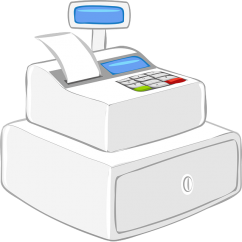Articles and News
May Retail Sales Reach Near-Record Level Despite Monthly Decline; Bullish NRF Revises Annual Forecast Upwards June 15, 2021 (0 comments)

Washington, DC—Retail sales remained at elevated levels in May despite month-to-month fluctuations that masked near-record performance, the National Retail Federation said Wednesday. Image: Pixabay
“While May retail sales were down slightly, largely due to supply chain constraints, the more accurate indicator remains in the year-over-year data which, as the NRF calculates, showed growth of over 17%,” NRF president and CEO Matthew Shay said. “For the first five months of this year, retail sales are already tracking 17.6% above the same five months of 2020, giving us further confidence in our newly revised sales forecast of growth between 10.5% and 13.5% to more than $4.44 trillion for 2021. While there are downside risks related to labor shortages, supply chain bottlenecks, tax increases and over-regulation, overall, households are healthier, and consumers are demonstrating their ability and willingness to spend. We are confident.”
“Month-over-month comparisons and percentages of change simply don’t tell the story,” NRF chief economist Jack Kleinhenz said. “We are at a highly elevated level of spending, with dollar amounts in recent months some of the highest we’ve ever seen. Long-term trends in the number of dollars spent tell much more about the continuing economic recovery than whether sales were up or down from month to month. Retail sales as calculated by NRF were the second highest on record in May, topped only by holiday spending in December. Demand has continued to be strong even as the concentrated impact from government stimulus has faded. There is still pent-up demand for retail goods and consumers are likely to remain on a growth path into the summer.”
This comes on top of the NRF’s revision of its annual retail forecast last week. The organization now anticipates retail sales will grow between 10.5% and 13.5%, to between $4.44 and $4.56 trillion this year as the economy accelerates its pace of recovery. In addition, NRF now projects full-year GDP growth to approach 7 %, compared with the 4.4% and 5% forecasted earlier this year.
“The economy and consumer spending have proven to be much more resilient than initially forecasted,” NRF President and CEO Matthew Shay said. “The combination of vaccine distribution, fiscal stimulus and private-sector ingenuity have put millions of Americans back to work. While there are downside risks related to worker shortages, an overheating economy, tax increases and over-regulation, overall households are healthier, and consumers are demonstrating their ability and willingness to spend. The pandemic was a reminder how essential small, mid-size and large retailers are to the everyday lives of Americans in communities nationwide.”
The revised forecast surpasses NRF’s initial projection of at least 6.5% growth, made in February of this year. The initial forecast was made when there was still great uncertainty about consumer spending, vaccine distribution, virus infection rates and additional fiscal stimulus, prior to passage of the American Rescue Plan Act.
The updated figures compare with $4.02 trillion in total retail sales in 2020. Of that, $920 billion was from purchases made through non-store and online channels.
Pre-pandemic levels of output are expected to return this quarter. “We are seeing clear signs of a strong and resilient economy,” NRF chief economist Jack Kleinhenz said. “Incoming data suggests that U.S. economic activity continues to expand rapidly, and we have seen impressive growth. Most indicators point toward an energetic expansion over the upcoming months and through the remainder of the year.”
The U.S. Census Bureau said overall retail sales in May were down 1.3% seasonally adjusted from April but up 28.1% year-over-year. That compares with increases of 0.9% month-over-month and 53.4% year-over-year in April. The year-over-year increases for both April and May were unusually high because most stores were closed by the pandemic during those months last year. Despite occasional month-over-month declines, sales have grown year-over-year every month since June 2020, according to Census data.
NRF’s calculation of retail sales—which excludes automobile dealers, gasoline stations and restaurants to focus on core retail—showed May was down 1.2% seasonally adjusted from April but up 17.3% unadjusted year-over-year. NRF’s numbers were up 22.3% unadjusted year-over-year on a three-month moving average.
May sales declined month-over-month in two-thirds of retail categories but were up year-over-year in every category except grocery stores, led by usually large increases at retailers like clothing, electronics and furniture stores that were ordered to close last spring. Specifics from key retail sectors include:
- Clothing and clothing accessory stores were up 3% month-over-month seasonally adjusted and up 198.7% unadjusted year-over-year.
- Electronics and appliance stores were down 3.4% month-over-month seasonally adjusted but up 90.8% unadjusted year-over-year.
- Furniture and home furnishings stores were down 2.1% month-over-month seasonally adjusted but up 64.7% unadjusted year-over-year.
- Sporting goods stores were down 0.8% month-over-month seasonally adjusted but up 40.9% unadjusted year-over-year.
- Health and personal care stores were up 1.8% month-over-month seasonally adjusted and up 25.8% unadjusted year-over-year.
- Building materials and garden supply stores were down 5.9% month-over-month seasonally adjusted but up 10.1% unadjusted year-over-year.
- General merchandise stores were down 3.3% month-over-month seasonally adjusted but up 9.3% unadjusted year-over-year.
- Online and other non-store sales were down 0.8% month-over-month seasonally adjusted but up 8.2% unadjusted year-over-year.
- Grocery and beverage stores were up 1% month-over-month seasonally adjusted but down 0.2% unadjusted year-over-year.







